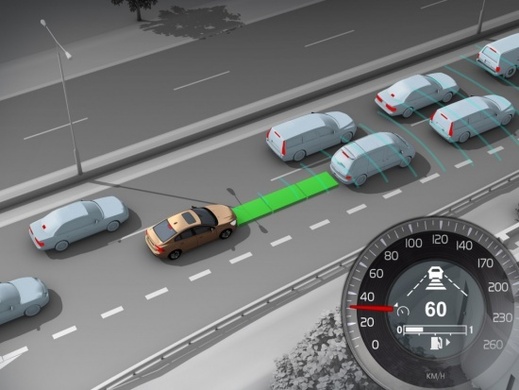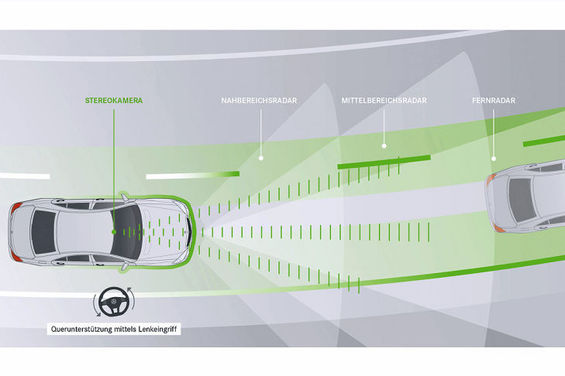
Adaptive cruise control-second round of cruise control. The main difference between adaptive cruise is the ability to monitor the road environment and adjust the speed of the car depending on the speed of the vehicle in front.
The first and only system of cruise control in Russia was established in 1956 on Volga by GAZ 21
The traditional cruise control was and remains a convenience for the motorist, saving the forces on the road. Adaptive cruise control also ensures safety, without end-checking the distance to the preceding car and keeping it at a constant level.
Types of adaptive cruise control
Adaptive control systems are developed in two ways. Some manufacturers limit the data obtained from the sensors to the vehicle. Others believe that this is not enough, and is developing second-generation devices. This adaptive cruise, using GPRS and GPS data streams, can interact with a similar device installed in another car and also uses navigational data, including road signs.
Regardless of the design, they do the same job-they maintain a constant velocity relative to the car. If a "driving" car reduces speed, the "slave" also starts to brake. The most complex systems also allow to increase speed if the distance increases, but there is no consensus about the safety of this function.
History of adaptive cruise control
The pioneer of adaptive cruise control was Mitsubishi Company, which established the first system with laser sensors in the Diamante model in 1995. The system from Mitsubishi was called the PDC-Preview Distance Control. She was only able to open and close the throttle and control the switching of the ACPR.
The National Highway Traffic Safety Administration (NHTSA) has officially declared that the cruise control is a security tool.
In 1997, Toyota offered the Celsior model buyers adaptive cruise with radar sensors. In the future, the company improved the system by adding the function of emergency braking and in 2004 the function of "speed reduction monitoring". The system warned the driver that the vehicle in front of the vehicle had started braking. However, the algorithm of her work was still too simple-after braking the cruise was turned off, passing further control to the driver. In 2006, Toyota released a new upgrade. The updated system introduced the "speed change tracking" function, ranging from 0 to 100 km per hour, with multiple acceleration support and stopper traffic stops. For the first time, the system was installed on Lexus LS 460.
Adaptive cruise control is in Stanley, robotic self-driving car driven by Volkswagen Passat
Mercedes presented his version of the Distronic at the end of 1998 S-Glass W220. In 2006, the updated Distronic Plus system, which was also launched on the E-Class cars, was complemented by the possibility of a complete stop of the car. The development of Adaptive Cruise Control for Mercedes was carried out by Robert Bosch, so the almost full version of Distronic Plus, called ACC plus, was installed on Audi Q7 and Q5, as well as Audi A6 from 2009 and Audi A8 2010.

In 2000, the ACC system appeared on BMW 7-series BMW cars. Later, in 2007, the adaptive cruise combined with the Stop-and-Go system received the possibility of BMW 5-series BMW. In 2002, Volkswagen presented its own version of the system developed by Autocruise.
Honda/Acura presented an adaptive cruise control as an option for Acura RL 2006, as well as for Acura MDX and Acura ZDX 2010.
Laser sensors or radars?
Each of the sensors has its pros and cons. The main disadvantage of lasers is the sensitivity to bad weather. In addition, they do not react to excessively dirty cars. There is another drawback-the laser sensor should be installed in a place where it has the maximum field of vision. The ideal position, defined by an experienced path, is the center of the decorative grille that closes the heat sink.
Radar sensors can be installed in any suitable location and hidden behind plastic fillers. For example, Daimler has found an elegant installation method for Mercedes S-lass-all the sensors are hidden behind the radiator grill, but the lower part of the grille is false. In order for the lower end of the grille to be no different from the upper part of the grille, the holes shall be filled. BMW found another solution: it is equipped with Models 5 and 6-series with the main sensor located in the center and two auxiliaires posted at the edges of the front of the car.

The systems for cars in the class below are guided by the testimony of one or two radars installed in the centre. Systems using the GPS data stream
Systems using the GPS data stream
At the moment, there are adaptive cruise control systems that use data flow for navigation. These systems are not only equipped with tracking sensors, but also a camera that transmits the image to the cruise control unit. With the camera, the system recognizes not only the illumination of stop lamps but also the direction indicator. Having found on the map of the Navigator the unwinding of the expressway, the system makes the conclusion that the car going in front and flashing is moving off the track, and therefore liberating the road. The normal system in this situation starts the braking immediately, while the intelligent cruise control is pausing, continuing to scan the road ahead. If the car really has freed the road, no braking occurs.
Adaptive Cruise Control of the Second Generation
Second generation systems should be able to communicate and communicate with each other through the Internet. A cruise control of one car finds the system installed in the car in front of the car and synchronizes with it, which allows to "learn" about the actions it is taking or is about to take. For example, if a "driving" car slows down speed, the machine "slave" is informed about it and issues a braking command.
In the new Mercedes S-class, the adaptive cruise control of Distronic Plus is merged with the Stering Assist system
The main problem in creating such systems is the lack of standardization between producers. However, the development of common infrastructure is considered very promising, as it will make it possible to make not only safer but also well regulated. Cars that support the specified interval automatically will help drivers not form traffic jams in loaded urban traffic.
Where there is no wireless, second-generation systems continue to work on their own rador or laser sensors.
Why Active Cruise Control is different for different manufacturers
Many manufacturers are developing their own "Smart Cruise Control" system development, so the same device in different execution is called different. Some systems have unique names, but most manufacturers are limited to the ACC name. Typically, adaptive cruise control is sold with other options in a single package. For example, BMW along with the Stop & Go option. The following is a list of some unique names.
- Mercedes-Benz-Distronic Plus
- Bentley-Follow-to-Stop
- Porsche-Porsche Active Safe (PAS)
- Toyota-Dynamic laser Cruise Control (DLCC)
- Lexus-Dynamic Radar Cruise Control
- Subaru-EyeSight Non-Radar Camera System
Among the manufacturers offering adaptive cruise as an option, such brands as Infiniti, Hyundai, Volkswagen and others.
Interesting facts about adaptive cruise control
Top Gear host Jeremy Clarkson "has developed" his own version of a simple and effective "adaptive cruise control", suggesting that the cars have large magnets. The idea of Clarkson's idea is to use the effect of pushing the multipolar magnets together. According to Clarkson, the cars in this case "won't crash."







